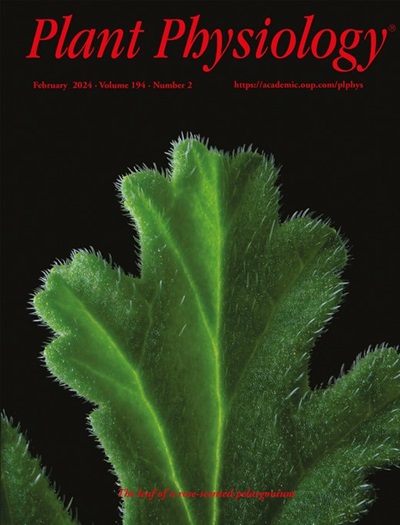拟南芥中二甲氰胺的形成需要dph1与DPH2相互作用以抵抗光和氧化胁迫
IF 6.5
1区 生物学
Q1 PLANT SCIENCES
引用次数: 0
摘要
双硫酰胺是真核生物转化延伸因子 2(eEF2)翻译后修饰的组氨酸残基,也是人类细胞中白喉毒素的靶标。在酵母和哺乳动物中,含 4Fe-4S 簇的蛋白质 Dph1 和 Dph2 催化双硫酰胺形成的第一个生物合成步骤。在这里,我们鉴定了拟南芥(Arabidopsis thaliana)DPH2,并证明它是双硫酰胺生物合成所必需的,定位在细胞质中并与 AtDPH1 发生物理相互作用。与野生型相比,拟南芥 dph2 突变体形成的主根更短,莲座丛更小,这与我们之前鉴定的 dph1 突变体相似。此外,dph2 突变体中核糖体-1 换帧错误率的增加和 RAPAMYCIN(TOR)激酶活性的减弱也与 dph1 突变体类似。除了已知的 dph1 的重金属超敏性和热休克耐受性之外,我们在此还表明,dph1 和 dph2 突变体对高光照强度和氧化胁迫都超敏,并且野生型拟南芥幼苗在氧化胁迫下会积累未修饰的 eEF2。这两种突变体都有 1,186 个转录本与几种环境和激素反应相关。AtDPH1 和 AtDPH2 不能与相应的酿酒酵母突变体互补。总之,DPH2 和 DPH1 相互作用,在双硫酰胺的形成、翻译保真度的维持、野生型生长速率和 TOR 激酶的激活等方面发挥相互依赖的功能,并且它们有助于减轻光照强度升高和氧化应激造成的损害。在氧化胁迫下,剂量依赖性的双硫酰胺损失会在前馈循环中增强下游效应。这项研究加深了我们对翻译及其与植物生长调控和胁迫响应之间相互作用的理解。本文章由计算机程序翻译,如有差异,请以英文原文为准。
Diphthamide formation in Arabidopsis requires DPH1-interacting DPH2 for light and oxidative stress resistance
Diphthamide is a post-translationally modified histidine residue of eukaryotic TRANSLATION ELONGATION FACTOR 2 (eEF2) and the target of diphtheria toxin in human cells. In yeast and mammals, the 4Fe-4S cluster-containing proteins Dph1 and Dph2 catalyze the first biosynthetic step of diphthamide formation. Here, we identify Arabidopsis (Arabidopsis thaliana) DPH2 and show that it is required for diphthamide biosynthesis, localizes to the cytosol and interacts physically with AtDPH1. Arabidopsis dph2 mutants form shorter primary roots and smaller rosettes than the wild type, similar to dph1 mutants which we characterized previously. Additionally, increased ribosomal -1 frameshifting error rates and attenuated TARGET OF RAPAMYCIN (TOR) kinase activity in dph2 mutants also phenocopy the dph1 mutant. Beyond the known heavy-metal hypersensitivity and heat shock tolerance of dph1, we show here that both dph1 and dph2 mutants are hypersensitive to elevated light intensities and oxidative stress, and that wild-type Arabidopsis seedlings accumulate diphthamide-unmodified eEF2 under oxidative stress. Both mutants share the deregulation of 1,186 transcripts associated with several environmental and hormone responses. AtDPH1 and AtDPH2 do not complement the corresponding mutants of Saccharomyces cerevisiae. In summary, DPH2 and DPH1 interact to function inter-dependently in diphthamide formation, the maintenance of translational fidelity, wild-type growth rates and TOR kinase activation, and they contribute to mitigating damage from elevated light intensities and oxidative stress. Under oxidative stress, a dose-dependent loss of diphthamide could potentiate downstream effects in a feed-forward loop. This work advances our understanding of translation and its interactions with growth regulation and stress responses in plants.
求助全文
通过发布文献求助,成功后即可免费获取论文全文。
去求助
来源期刊

Plant Physiology
生物-植物科学
CiteScore
12.20
自引率
5.40%
发文量
535
审稿时长
2.3 months
期刊介绍:
Plant Physiology® is a distinguished and highly respected journal with a rich history dating back to its establishment in 1926. It stands as a leading international publication in the field of plant biology, covering a comprehensive range of topics from the molecular and structural aspects of plant life to systems biology and ecophysiology. Recognized as the most highly cited journal in plant sciences, Plant Physiology® is a testament to its commitment to excellence and the dissemination of groundbreaking research.
As the official publication of the American Society of Plant Biologists, Plant Physiology® upholds rigorous peer-review standards, ensuring that the scientific community receives the highest quality research. The journal releases 12 issues annually, providing a steady stream of new findings and insights to its readership.
 求助内容:
求助内容: 应助结果提醒方式:
应助结果提醒方式:


